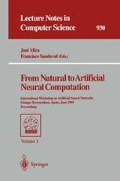Abstract
In many Signal Processing applications, data sampled by sensors comprise a mixture of signals from different sources. The problem of separation lies in the reconstruction of sources from the mixtures. In this paper a new method is proposed for the separation of sources, based on geometrical considerations. After a brief introduction, we present the principles of the new method and provide a description of the algorithm and map this on an artificial neural network. Finally we give examples with synthetic and real signals to illustrate the efficiency and utility of the network.
Preview
Unable to display preview. Download preview PDF.
References
J.-F. Cardoso, “Super-symmetric decomposition of the fourth-order cumulant tensor, blind identification of more sources than sensors”, Proc. International Conf. Acoust. Speech Signal Process '91, 14–17 May 1991.
P. Comon, “Separation of sources using high-order cumulants”, SPIE Conference on Advanced Algorithms and Architectures for Signal Processing, Vol. Real-time Signal Processing XII, San Diego, California, Aug. 8–10, 1989, pp. 170–181.
J. Hérault, C. Jutten and B. Ans, “Detection de grandeurs primitives dans un message composite par une architecture de calcul neuro-mimetique en apprentissage non supervisé.” 10th GRETSI, Nice, France, pp. 1017–1022, 1985.
C. Jutten, J. Hérault, P. Comon and E. Sorouchiary, “Blind separation of sources”, Parts I, II and III, Signal Processing, Vol. 24, No. 1, July 1991, pp. 1–29.
J.-L. Lacoume and P. Ruiz, “Sources identification: A solution based on the cumulants”, Proceedings of the 4th ASSP Workshop on Spectral Estimation and Modelling. Minneapolis, USA, Aug. 1988, pp. 199–203.
L.H. Nguyen Thi, C. Jutten and J. Caelen, “Speech enhancement: Analysis and comparison of methods on various real situations”, Proceedings of EUSIPCO-92, Brussels (Belgium), Aug. 24–27, 1992, pp. 303–306.
C.G. Puntonet, “Nuevos algoritmos de separación de fuentes en medios lineales”, Ph. D. Thesis, University of Granada, Spain, September, 1994.
Author information
Authors and Affiliations
Editor information
Rights and permissions
Copyright information
© 1995 Springer-Verlag Berlin Heidelberg
About this paper
Cite this paper
Puntonet, C.G., Rodríguez-Alvarez, M., Prieto, A. (1995). A geometrical based procedure for source separation mapped to a neural network. In: Mira, J., Sandoval, F. (eds) From Natural to Artificial Neural Computation. IWANN 1995. Lecture Notes in Computer Science, vol 930. Springer, Berlin, Heidelberg. https://doi.org/10.1007/3-540-59497-3_265
Download citation
DOI: https://doi.org/10.1007/3-540-59497-3_265
Published:
Publisher Name: Springer, Berlin, Heidelberg
Print ISBN: 978-3-540-59497-0
Online ISBN: 978-3-540-49288-7
eBook Packages: Springer Book Archive

